The third grade team is planning for a dot image number talk that focuses on this standard:
“Apply properties of operations as strategies to multiply and divide.2Examples: If 6 × 4 = 24 is known, then 4 × 6 = 24 is also known. (Commutative property of multiplication.) 3 × 5 × 2 can be found by 3 × 5 = 15, then 15 × 2 = 30, or by 5 × 2 = 10, then 3 × 10 = 30. (Associative property of multiplication.) Knowing that 8 × 5 = 40 and 8 × 2 = 16, one can find 8 × 7 as 8 × (5 + 2) = (8 × 5) + (8 × 2) = 40 + 16 = 56. (Distributive property.)”
Before this talk the students have been doing work with equal groups and are moving into array work with the arranging chairs activity in Investigations. They have also been doing dot images with smaller groups and have noticed the commutative property as arranging the same dots into different-sized groups.
These are the three images we are playing around with and anticipating which would would draw out the most interesting strategies based on the properties. We are thinking of having a journal entry afterwards to see if students make any connections between the strategies.
So if you feel like playing around with some dot images and doing some math, I would love anyone’s thoughts on which image you would choose and why!
The start of my planning….
My new thoughts on these images and responses…
After chatting with a few friends yesterday and thinking about which image would elicit the most expressions that could allow students to see some connections between the properties of operations, I am thinking about some changes to the images (in orange).
In image 1, I am wondering if we should split each group of 8 into fours but leave a bigger space between the top four groups and bottom four groups. It may allow students to better see the 4’s and then group them as 8’s and at the same time thinking about “doubling” the top group to get the total because of symmetry. They could then explore ideas like (4 x 4) + (4 x 4) = 4 x 4 x 2 or (4 x 2) x 4 = (4 x 4) x 2 [associative property] or 8 x 4 = (4×4) + (4 x 4) [distributive property] or any fun mix of them. If we leave it as it is, I think it may be hard to move them past 4 x 8, skip counting by 8’s or using 2’s.
In the second image, I love the structure of it but am wondering how students could use that 4 in the middle aside from just adding it on each time? Will we just end up with a lot of expressions with “+4” at the end? I am wondering what would happen if we adding an extra group of four next to it? Would students see the structure of a 5 and double it in some way? (5×4)x2 = 10 x 4 or 5x(2×4)=(5×4)x2 [associative] or 5 x 8 = 10 x 4 [doubling/halving] or 2×4 + 2×4 + 2×4 + 2×4 + 2×4 = 10 x 4
Then what question to pose at the end? Do we ask them to freely choose two expressions and explain how they are equal? or Do we choose the two we want them to compare? Do we have the dot image printed at the top of the page for them to use in their entry?
So much to think about..
~Kristin
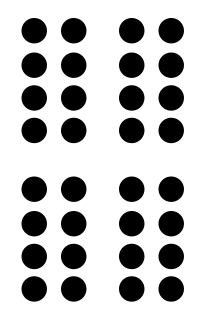
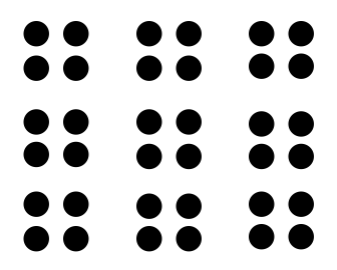

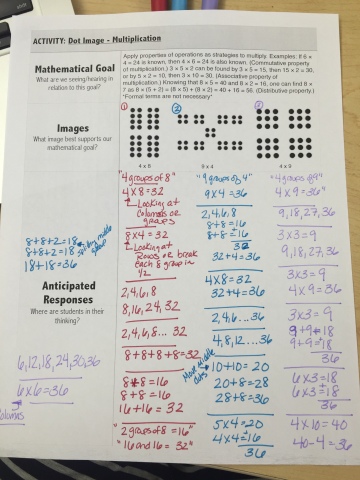
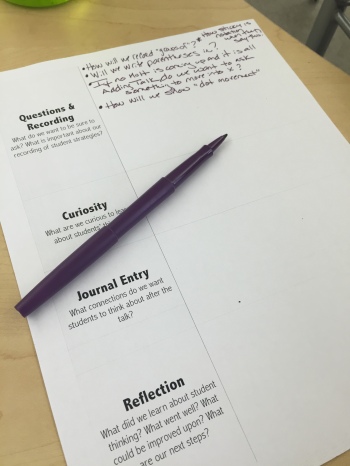
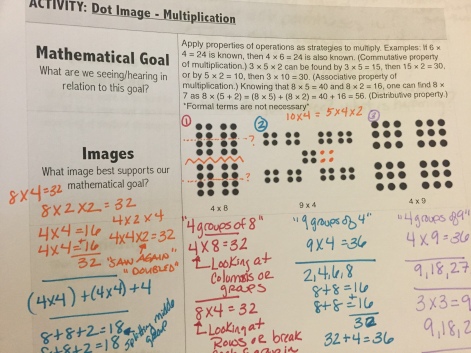
My suggestion is towards the constructional. Make some square cards with four dots on
O O
O O
and get them to create a bigger square or rectangle, then figure out ways of finding the total number of dots. You could use a 2×3 arrangement as well
O O O
O O O
Do the same, and then see if any of them can make the same shape with 4 dot cards and with 6 dot cards.
What matters is that they get some clues as to what is going on. The “properties of operations” thing is very abstract unless you use simple language such as “you can add some numbers together and it doesnt matter about the order”, and so on.
One of the really unfortunate things about the CCSSM is not what they say but the dumb way it has been interpreted by curriculum writers. I am thinking about “The old way” vs ‘The new way” stuff.
Have fun!
LikeLike
My experience is with middle schoolers, so I don’t know if or when this might work in third, but I am wondering if you might get at the 2x3x5 idea by making a large array that is 6 by 5 or 6 by 10 or even 12 by 15 and asking them to find smaller groups in it… have them draw lines to separate it into an array of 6s (2×3) or 4s. (Looking back at your examples, I would take the gaps out of the first two and offer them up as one solid array…have the students make their own subdivisions).
LikeLike
I like the last one. I think it offers the most potential for all the properties.
LikeLike
Kristen, I love the reflection template you are using. Is this something you have developed yourself or as part of a team, or is it part of a different published resource?
LikeLike
Thanks so much Kit! It is something I developed. After reading the 5 Practices book and many convos with Elham Kazemi, who has Math Labs, I pulled the things I thought were most important!
LikeLike
Thanks – this gives me something to think about in my work supporting teachers with their inquiries with Number Talks, Number Strings.
LikeLike
Kristen,
In the video of the this lesson (https://www.teachingchannel.org/blog/2016/02/12/learning-lab-playlist-gbt/) you mention a progression of understanding. What is this progression? Is it a progression of understanding of multiplication? Is a progression that outlines a larger scope for dot talks?
Thanks
LikeLike
Pingback: Learning from Sea to Shining Sea | Global Math Department